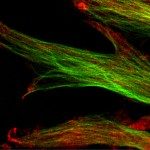Link to Pubmed [PMID] – 28597954
Biol. Cell 2017 Aug;109(8):293-311
BACKGROUND INFORMATION: The adenylate cyclase (CyaA) toxin is a major virulent factor of Bordetella pertussis, the causative agent of whooping cough. CyaA toxin is able to invade eukaryotic cells where it produces high levels of cyclic adenosine monophosphate (cAMP) affecting cellular physiology. Whether CyaA toxin can modulate cell matrix adhesion and mechanics of infected cells remains largely unknown.
RESULTS: In this study, we use a recently proposed multiple bond force spectroscopy (MFS) with an atomic force microscope to assess the early phase of cell adhesion (maximal detachment and local rupture forces) and cell rigidity (Young’s modulus) in alveolar epithelial cells (A549) for toxin exposure 95%) at CyaA concentration of 0.5 nM, but a significant effect (≈81%) at 10 nM. MFS performed on A549 for three different concentrations (0.5, 5 and 10 nM) demonstrates that CyaA toxin significantly affects both cell adhesion (detachment forces are decreased) and cell mechanics (Young’s modulus is increased). CyaA toxin (at 0.5 nM) assessed at three indentation/retraction speeds (2, 5 and 10 μm/s) significantly affects global detachment forces, local rupture events and Young modulus compared with control conditions, while an enzymatically inactive variant CyaAE5 has no effect. These results reveal the loading rate dependence of the multiple bonds newly formed between the cell and integrin-specific coated probe as well as the individual bond kinetics which are only slightly affected by the patho-physiological dose of CyaA toxin. Finally, theory of multiple bond force rupture enables us to deduce the bond number N which is reduced by a factor of 2 upon CyaA exposure (N ≈ 6 versus N ≈ 12 in control conditions).
CONCLUSIONS: MFS measurements demonstrate that adhesion and mechanical properties of A549 are deeply affected by exposure to the CyaA toxin but not to an enzymatically inactive variant. This indicates that the alteration of cell mechanics triggered by CyaA is a consequence of the increase in intracellular cAMP in these target cells.
SIGNIFICANCE: These results suggest that mechanical and adhesion properties of the cells appear as pertinent markers of cytotoxicity of CyaA toxin.
